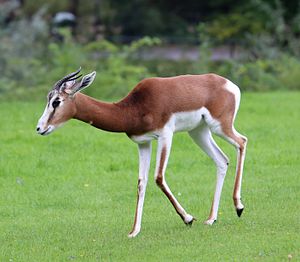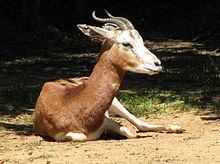Damagazelle
| Damagazelle | ||||||||||||
|---|---|---|---|---|---|---|---|---|---|---|---|---|

Damagazelle ( Nanger dama ) |
||||||||||||
| Systematics | ||||||||||||
|
||||||||||||
| Scientific name | ||||||||||||
| Nanger dama | ||||||||||||
| ( Pallas , 1766) |
The Damagazelle ( Nanger dama , Syn .: Gazella dama ) is a type of gazelle from the family of horned bearers (Bovidae). This large, strikingly red and white patterned gazelle lives in northern Africa and is highly threatened with extinction.
Surname
The origin of the name is controversial. While some attribute the name to the fallow deer (Latin dama ), others see the Arabic dammar ("sheep") as a model for the name.
features
Dama cells are among the largest gazelles. They reach a head trunk length of 140 to 165 centimeters, a shoulder height of 90 to 120 centimeters and a weight of 40 to 75 kilograms. The color of the fur is variable: the face, abdomen and buttocks are white, the neck is red-brown, and there is always a characteristic white spot on the throat. In the western populations ( Mhorr gazelle , N. d. Mhorr ) the trunk is predominantly red-brown in color, while in the eastern populations (Red-necked gazelle, N. d. Ruficollis ) the body is predominantly white and only the neck and back are brownish. The color of the face is also variable: in eastern Dama cells it is pure white, in animals living further west there is a black stripe that leads from the eyes to the snout. The horns are bent into an S-shape and 20 to 45 centimeters long, as with all gazelles, the horns of the males are larger than those of the females.
distribution and habitat
The original distribution area of the Damagazelle encompassed the whole of northern Africa and extended from Morocco and Senegal to Sudan . Mainly due to the heavy hunting, their habitat has decreased drastically, today only a few thousand animals live between Senegal (where the species was reintroduced) and Chad . Their habitat are dry, open areas such as grasslands, semi-deserts and desert regions. They undertake seasonal migrations between the Sahara and the Sahel zone.
Lifestyle and diet
Dama cells live together in groups, the size of which changes according to the season. In the rainy season, when they migrate in desert regions, they form groups of sometimes several hundred animals; in the dry season, when they move to more humid regions, they form smaller groups of mostly 15 to 20 animals. Such groups are often harem groups, which consist of one male, several females and the common offspring; However, there are also groups that are composed only of females and young animals, as well as associations of males, so-called bachelor groups. During the mating season, the male establishes a mating area from which it drives other males.
Damagazelles, like all gazelles, are herbivores and feed on leaves and herbs. Sometimes, similar to giraffe gazelles, they rise up on their hind legs to feed .
Reproduction
The mating takes place in the months of August to October, after a five to six month gestation period, the female usually gives birth to a single young. This is weaned after three to four months and reaches sexual maturity at one to two years. Life expectancy in the wild is a maximum of twelve years, animals in captivity can live to be almost 20 years old.
Systematics
The sources usually differentiate between two to five subspecies, of which three have recently been generally recognized: the nominate form ( Nanger d. Dama ), the Mhorr gazelle ( N. d. Mhorr ) and the red-necked gazelle ( N. d. Ruficolis ). Molecular genetic studies, however, contradict a division of the Damaga cell into several subspecies. The numerous color variations, which are often used as criteria for these individual subspecies, are therefore possibly due to clinical adaptations.
threat
The main reason for the drastic decline in the population was hunting, especially since the introduction of motorized hunting methods. In addition, their range is often converted into pastures for cattle and animals are forced to retreat to drier, less suitable habitats. The only larger populations today live in Chad , Niger and Mali . In Senegal today there is a small, resettled population, in other countries (such as Sudan and Algeria ) there may also be small populations. The total population is estimated to be less than 500 animals, the IUCN lists the species as " critically endangered ".
In some zoos, attempts are being made to preserve the species by breeding the traditionally recognized subspecies Mhorr's gazelle and red-necked gazelle; the former is already extinct in the wild.
Dama cells in culture
The nickname of the Nigerien national soccer team is Ména , the name of the Damagazelle in the national language Hausa . The Fédération Nigérienne de Football , the national football association of Niger, uses the Dama cell as their emblem and in their logo.
literature
- Ronald M. Nowak: Walker's Mammals of the World . The Johns Hopkins University Press, Baltimore 1999, ISBN 0-8018-5789-9 .
Web links
- Damagazelle on Animal Diversity Web
- Photos, distribution map and more information on Ultimate Ungulate
- Detailed population figures on Animal Info
- Nanger then in the endangered Red List species the IUCN 2006 Posted by: J. Newby, T. & F. supervisor Lamarque, 2005. Accessed on 1 1 of 2007.
Individual evidence
- ↑ Jürgen Lange: A contribution to the systematic position of the mirror gazelles (Genus Gazella Blainville, 1816 Subgenus Nanger Lataste, 1885). Journal for Mammalian Science 36, 1971, pp. 1-18
- ↑ Colin P. Groves and David M. Leslie Jr .: Family Bovidae (Hollow-horned Ruminants). In: Don E. Wilson and Russell A. Mittermeier (eds.): Handbook of the Mammals of the World. Volume 2: Hooved Mammals. Lynx Edicions, Barcelona 2011, ISBN 978-84-96553-77-4 , pp. 636-637
- ↑ Colin P. Groves and Peter Grubb: Ungulate Taxonomy. Johns Hopkins University Press, 2011, pp. 1-317 (pp. 161-162)
- ↑ a b Helen Senn, Lisa Banfield, Tim Wacher, John Newby, Thomas Rabeil, Jennifer Kaden, Andrew C. Kitchener, Teresa Abaigar, Teresa Luísa Silva, Mike Maunder, Rob Ogden: Splitting or Lumping? A Conservation Dilemma Exemplified by the Critically Endangered Dama Gazelle (Nanger dama). June 23, 2014, accessed April 30, 2016 .
- ^ J. Newby, T. Wacher, F. Lamarque, F. Cuzin and K. de Smet: Nanger dama. The IUCN Red List of Threatened Species 2008. e.T8968A12941085 ( [1] ); last accessed on April 30, 2016
- ↑ Schönbrunn: Rare Mhorr Gazelle born. orf.at, April 29, 2016, accessed April 30, 2016 .
- ↑ Jonathan Josephs: Niger's taxing journey to the Africa Cup of Nations. In: BBC News. January 23, 2012, accessed July 28, 2017 .
- ↑ Receuil des textes de la FENIFOOT. (PDF) Fédération Nigérienne de Football, p. 5 , accessed on July 28, 2017 (French).

